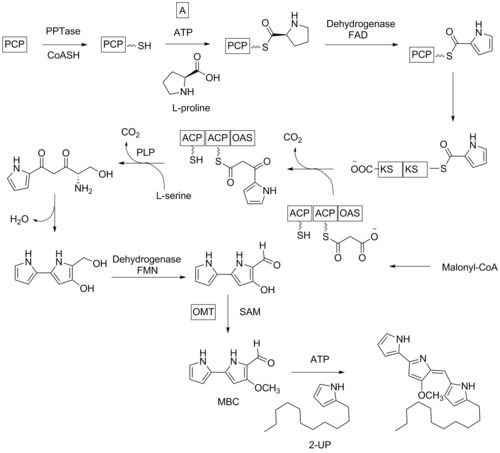Undecylprodigiosin
Undecylprodigiosin is an alkaloid produced by Streptomyces bacteria. It is one of the prodiginines pigments that is used for different medical uses including antimalarial activity.
 | |
| Names | |
|---|---|
| IUPAC name
(2Z,5Z)-3-Methoxy-5-pyrrol-2-ylidene-2-[(5-undecyl-1H-pyrrol-2-yl)methylidene]pyrrole | |
| Identifiers | |
3D model (JSmol) |
|
| ChEMBL | |
| ChemSpider | |
PubChem CID |
|
| |
| |
| Properties | |
| C25H35N3O | |
| Molar mass | 393.575 g·mol−1 |
Except where otherwise noted, data are given for materials in their standard state (at 25 °C [77 °F], 100 kPa). | |
| Infobox references | |
Biosynthesis
The biosynthesis of undecylprodigiosin starts with PCP apoprotein which is transformed into the holoprotein using acetyl CoA and PPtase then adenylation occurs utilizing L-proline and ATP. The resulting molecule is then oxidized by dehydrogenase enzyme. Elongation by decarboxylative condensation with malonyl CoA is followed by another decarboxylative condensation with L-serine using α-oxamine synthase (OAS) domain. The compound is then cyclized, oxidized with dehydrogenase and methylated with SAM to give 4-Methoxy-2,2′-bipyrrole-5-carboxaldehyde (MBC) intermediate which react with 2-undecylpyrrole (2-UP) to give undecylprodigiosin.[1]

References
- Hu, Dennis X.; Withall, David M.; Challis, Gregory L.; Thomson, Regan J. (17 June 2016). "Structure, Chemical Synthesis, and Biosynthesis of Prodiginine Natural Products". Chemical Reviews. 116 (14): 7818–7853. doi:10.1021/acs.chemrev.6b00024. PMC 5555159. PMID 27314508.